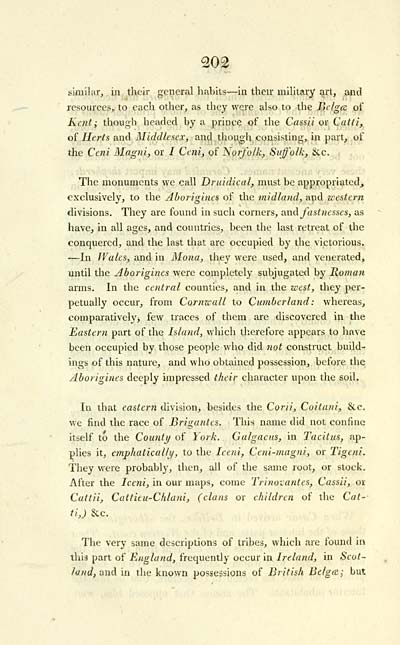Blair Collection > Celtic researches, on the origin, traditions & language, of the ancient Britons
(292)
Download files
Complete book:
Individual page:
Thumbnail gallery: Grid view | List view

202
«imilar, in their general habits — in their mihtary art, and
resources, to each other, as they were also to the Bclgis of
Kent; though headed by a prince of the Cassil or Catti,
of Herts and Middlesex y and thouoh consisting, in part, of
the Ceni Magni, or / Ceni, of Norfolk, Suffolk, ^c. . ,
The monuments vie call Dru'idical, must be appropriated,
exclusively, to the Aborigines of the midland, apd western
divisions. They are found in such corners, and fastnesses, as
have, in all ages, and countries, been the last retreat of the
conquered, and the last that are occupied by the victorious.
— In ÍValcs, and in Mono, they were used, and venerated,
until the Aborigines were completely subjugated by Roman
arms. In the central counties, and in the west, they per-
petually occur, from Cornwall to Cumberland : whereas,
comparatively, few traces of them are discovered in the
Eastern part of the Island, which therefore appears to have
been occupied by those people who did not construct build-
ings of this nature, and who obtained possession, before the
Aborigines deeply impressed their character upon the soil.
In that eastern division, besides the Corii, Coitani, &c.
we find the race of Brigantes. This name did not confine
itself to the Counti/ of York. Galgacus, in Taeitus, ap-
plies it, emphatically, to the Iceni, Ceni-tnagni, or Tigeni.
They were probably, then, all of the same root, or stock.
After the Iceni, in our maps, come Trinovantes, Cassii, or
Cattii, Cattieu-Chlani, (clans or children of the Cat-
ti,) 8cc.
The very same descriptions of tribes, which are found in
thiâ part of England, frequently occur in Ireland, in Scot-
land, and in the known possessions of British Belgce; but
«imilar, in their general habits — in their mihtary art, and
resources, to each other, as they were also to the Bclgis of
Kent; though headed by a prince of the Cassil or Catti,
of Herts and Middlesex y and thouoh consisting, in part, of
the Ceni Magni, or / Ceni, of Norfolk, Suffolk, ^c. . ,
The monuments vie call Dru'idical, must be appropriated,
exclusively, to the Aborigines of the midland, apd western
divisions. They are found in such corners, and fastnesses, as
have, in all ages, and countries, been the last retreat of the
conquered, and the last that are occupied by the victorious.
— In ÍValcs, and in Mono, they were used, and venerated,
until the Aborigines were completely subjugated by Roman
arms. In the central counties, and in the west, they per-
petually occur, from Cornwall to Cumberland : whereas,
comparatively, few traces of them are discovered in the
Eastern part of the Island, which therefore appears to have
been occupied by those people who did not construct build-
ings of this nature, and who obtained possession, before the
Aborigines deeply impressed their character upon the soil.
In that eastern division, besides the Corii, Coitani, &c.
we find the race of Brigantes. This name did not confine
itself to the Counti/ of York. Galgacus, in Taeitus, ap-
plies it, emphatically, to the Iceni, Ceni-tnagni, or Tigeni.
They were probably, then, all of the same root, or stock.
After the Iceni, in our maps, come Trinovantes, Cassii, or
Cattii, Cattieu-Chlani, (clans or children of the Cat-
ti,) 8cc.
The very same descriptions of tribes, which are found in
thiâ part of England, frequently occur in Ireland, in Scot-
land, and in the known possessions of British Belgce; but
Set display mode to: Large image | Transcription
Images and transcriptions on this page, including medium image downloads, may be used under the Creative Commons Attribution 4.0 International Licence unless otherwise stated. ![]()
| Early Gaelic Book Collections > Blair Collection > Celtic researches, on the origin, traditions & language, of the ancient Britons > (292) |
|---|
| Permanent URL | https://digital.nls.uk/75767107 |
|---|
| Description | A selection of books from a collection of more than 500 titles, mostly on religious and literary topics. Also includes some material dealing with other Celtic languages and societies. Collection created towards the end of the 19th century by Lady Evelyn Stewart Murray. |
|---|
| Description | Selected items from five 'Special and Named Printed Collections'. Includes books in Gaelic and other Celtic languages, works about the Gaels, their languages, literature, culture and history. |
|---|

